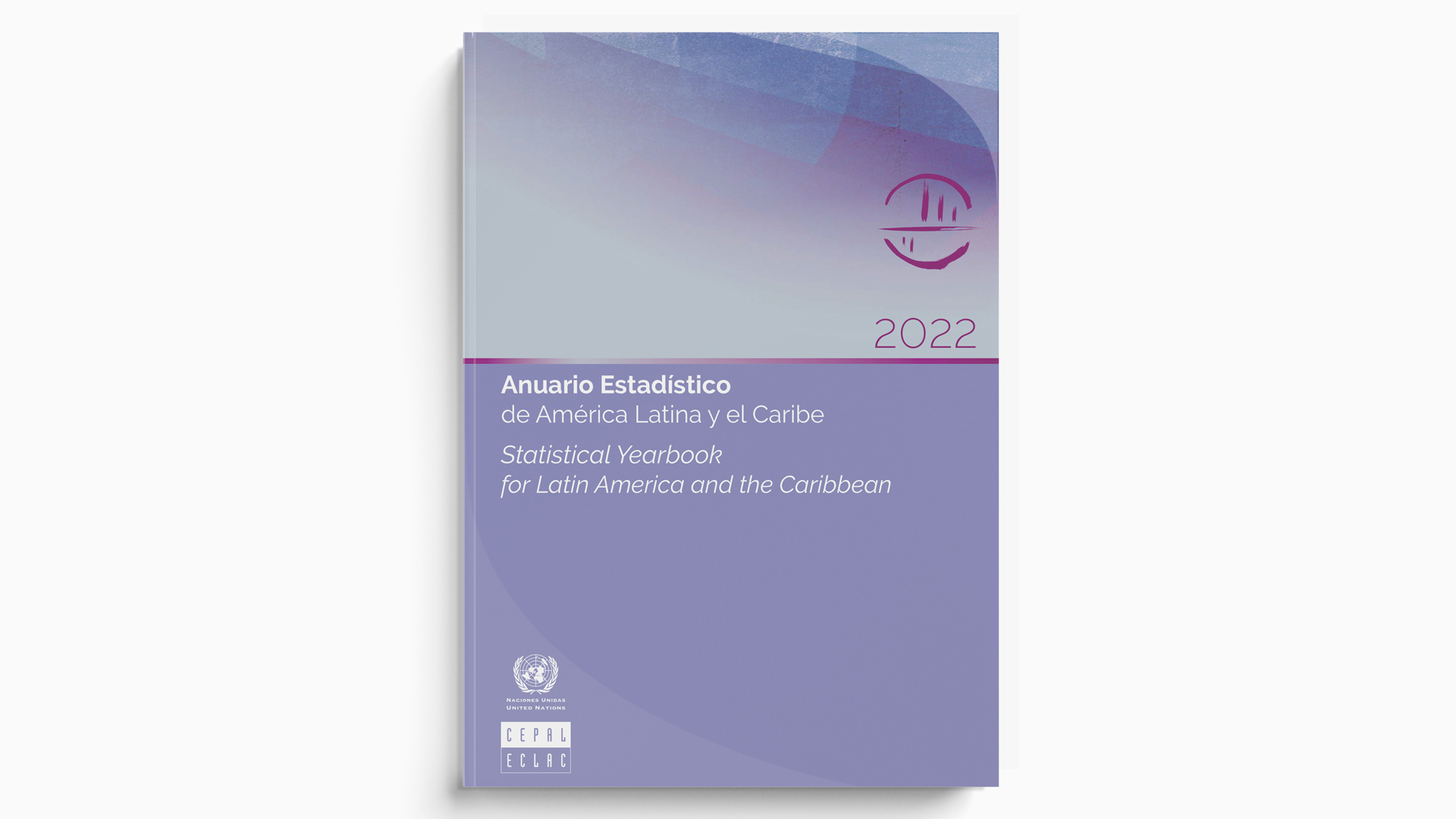ECLAC Presents a Selection of Key Statistics on Development in the Region’s Countries
Work area(s)
The 2022 version of the Statistical Yearbook includes selected indicators on Latin America and the Caribbean’s economic, social and environmental situation.

The Economic Commission for Latin America and the Caribbean (ECLAC) released today the Statistical Yearbook for Latin America and the Caribbean 2022, available online, in which it presents a statistical synthesis that illustrates the socio-demographic, economic and environmental development of the region’s countries.
This annual publication, which is among the United Nations regional organization’s most important, constitutes a reference for those seeking descriptive statistical data that is comparable between countries and over time. The current edition contains information available as of mid-December 2022.
The Statistical Yearbook 2022 is divided into three chapters. The first explores demographic and social aspects, including indicators on population, work, education, health, housing and basic services, poverty and income distribution, and gender.
In the social realm, the Yearbook’s data shows a slight recovery in some indicators after the COVID-19 pandemic. In 2021, poverty in Latin America affected 32.3% of the population, including 12.9% of the population that was living in extreme poverty. These figures represent a small decline versus the prior year, of 0.5 percentage points in poverty and 0.2 points in extreme poverty.
The pandemic’s impact on employment continued despite a slight improvement in labor indicators. The population’s participation rate in economic activity for Latin America and the Caribbean rose to 61.4% in comparison with the minimum of 57.8% reached in 2020. In addition, the open unemployment rate declined, falling from 10.5% in 2020 to 9.3% in 2021. In both cases, however, the improvements seen in 2021 were not enough for these indicators to attain their pre-pandemic values.
The second chapter presents economic information referring to national accounts, balance of payments, foreign trade and price indices, among other indicators.
The Yearbook shows that in 2022, the region’s economies grew at an estimated 3.7%, marking nearly half the growth recorded in 2021 (6.7%). This reflects the dwindling of the rebound effect on the recovery in 2021, along with the impact and effects of restrictive monetary policies, greater limits on fiscal spending, lower consumption and investment levels, and a deterioration in the external context.
While growth decelerated in 2022, inflationary pressures held firm. The variation in the Consumer Price Index in Latin America reached 15.4% in 2022, above the 12.4% seen in 2021. Food prices, which have played a significant role in the evolution of the overall consumer price index, rose by 13.2% in 2022, compared with 8.3% in 2021. The behavior of regional inflation also correlates with the evolution of prices for primary products, which increased by 16.6% between January and October 2022 versus the prior year, with particularly striking price growth of 45.9% for energy products, 36.8% for fertilizers and 19.5% for food and beverages.
The region’s complex domestic scenario is compounded by a difficult situation in the external sector. In 2021, Latin America and the Caribbean had a current account deficit in its balance of payments of 1.5% of GDP, with a deterioration in the trade balance of the region as a whole, influenced by growth of 34.7% in goods imports, which exceeded the 27.7% expansion for goods exports. However, in 2021 foreign direct investment experienced a recovery with 14.0% growth in net flows versus the 20.4% drop seen in 2020.
The third chapter offers environmental statistics and indicators from the region. These include metrics on physical conditions; land cover; ecosystems; biodiversity; environmental quality; land; energy, water and biological resources; emissions; disasters; human settlements; and environmental regulation and governance.
Historically, Latin America and the Caribbean has contributed less than other regions to climate change. However, the countries in this region are very vulnerable to its negative consequences: floods, storms, droughts and landslides, among others. In 2022 alone, 74 hazardous events and disasters occurred, directly affecting more than 7 million people and causing the death of more than 1,000 people. The total damage and economic losses related directly or indirectly to disasters in 2022 in our region amounted to $1.789 billion dollars.
On another note, it can be seen that since 1990, the region increased its accumulated aquaculture production by more than 1,547%, going from 229,611 tonnes in 1990 to 3,781,004 tonnes as of 2020. Meanwhile, fish extraction declined by 22%. All of this points to less pressure on these natural resources, leading to a less unfavorable impact on the environment.
Finally, this edition of the Statistical Yearbook includes information on environmental quality in the region through air quality (air pollution), which represents a significant environmental risk to human health. The results indicate that just 30% of the region’s countries (10 out of 33) comply with the World Health Organization’s guidelines for particulate matter (PM2.5) and, unfortunately, 5 countries have more than double the maximum value permitted.
The Statistical Yearbook is published in a print version and an online format that include a selection of tables and graphs aimed at providing a summary of the statistical information from a regional perspective. The interactive web version facilitates navigation and access to the information presented in the print version, linking graphs and statistical tables to the data series available in ECLAC’s databases, which allows for accessing information that is more detailed and refers to a much broader historical period. It also contains an additional chapter explaining methodological aspects and specifying the references to the data sources used.
The information underpinning the Yearbook is part of the set of statistics available on CEPALSTAT, a platform that gives access to all the updated statistical information from the region’s countries that is collected, systematized and published by ECLAC, enabling visualization of the region’s statistics in distinct territories through its Geoportal.
Given that most of this information comes from national statistics offices, central banks, international bodies and other official institutions, ECLAC invites users to pay attention to the sources and the technical notes presented in this publication. The data is obtained using international methodologies and standards with the aim of ensuring the greatest possible comparability between countries, which means that these figures may not necessarily coincide with national data.
Related content
Related link(s)
Country(ies)
- Latin America and the Caribbean
Contact
Public Information Unit
- prensa@cepal.org
- (56 2) 2210 2040
